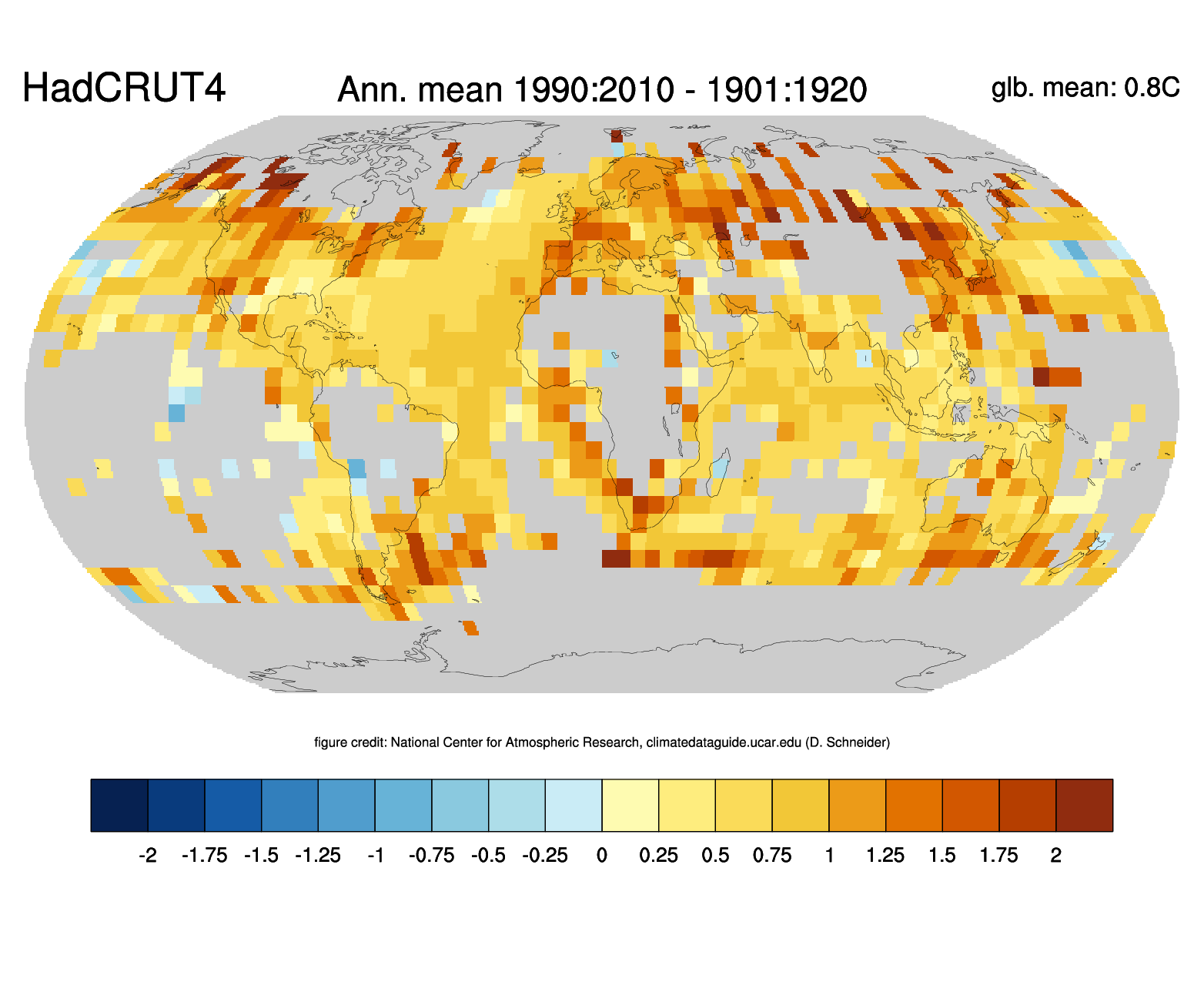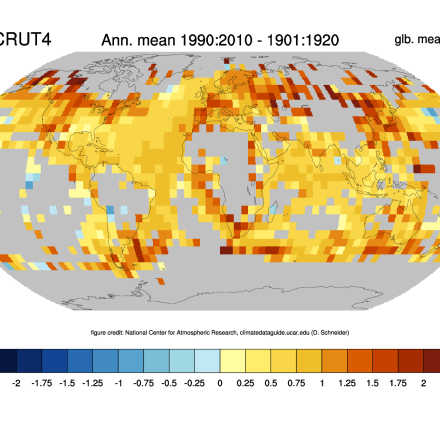Global surface temperature data: HadCRUT4 and CRUTEM4

Extending back to 1850 and frequently updated, HadCRUT4 is the longest data set of its type. HadCRUT4 is a combination of the global land surface temperature data set, CRUTEM4 and the global SST data set, HadSST3. HadCRUT4 is different from the most closely comparable products (e.g. NASA GISTEMP and NOAA MLOST) in that no interpolation is performed. As such, there are many coverage gaps; this may be a limiting factor in regional analyses but hemispheric and global means are very consistent with other data sets. Extensive analysis has been done to characterize uncertainties arising from non-climatic factors, for example changing instrumentation and observing practices, changes in station location, and changes in local land use. The resulting distribution of uncertainty is presented as an ensemble of 100 realizations of the data set. Individual ensemble members may be accessed via the Met Office webpage, though many users will likely focus on the ensemble median fields that are distributed online by CRU, Hadley Centre and other organizations.
In late 2020, the Met Office Hadley Centre released HadCRUT5. HadCRUT5 is offered in two different versions. The first version is similar to HadCRUT4 in that no interpolation has been performed to infill grid cells with no observations. Major updates include using HadSST4 in place of HadSST3, as well as enlarging the ensemble size to model the uncertainty distribution. The second, "analyzed" version is an infilled, globally complete dataset. See the link to HadCRUT5 in the sidebar for more information.
Key Strengths
Incorporates many additional data sources beyond GHCN
Explicit uncertainty analyses and separate land & ocean data sets
Grid-box averaging only; less analysis and smoothing/interpolation than comparable data sets for both land and ocean domains
Key Limitations
More spatial coverage gaps than comparable data sets; not analyzed or infilled like GISTEMP, UDEL or MLOST
In part due to these coverage gaps and in part due to the SST analysis, HadCRUT4 tends to under-sample recent global-mean surface warming relative to similar datasets from NOAA, NASA, and Berkeley Earth
Cite this page
Acknowledgement of any material taken from or knowledge gained from this page is appreciated:
National Center for Atmospheric Research Staff (Eds). Last modified "The Climate Data Guide: Global surface temperature data: HadCRUT4 and CRUTEM4.” Retrieved from https://climatedataguide.ucar.edu/climate-data/global-surface-temperature-data-hadcrut4-and-crutem4 on 2025-12-27.
Citation of datasets is separate and should be done according to the data providers' instructions. If known to us, data citation instructions are given in the Data Access section, above.
Acknowledgement of the Climate Data Guide project is also appreciated:
Schneider, D. P., C. Deser, J. Fasullo, and K. E. Trenberth, 2013: Climate Data Guide Spurs Discovery and Understanding. Eos Trans. AGU, 94, 121–122, https://doi.org/10.1002/2013eo130001
Key Figures
Other Information
- Morice, C.P., Kennedy, J.J., Rayner, N.A. and Jones, P.D., 2012: Quantifying uncertainties in global and regional temperature change using an ensemble of observational estimates: the HadCRUT4 dataset. J. Geophys Res., 117, D08101.
- Jones, P.D., Lister, D.H., Osborn, T.J., Harpham, C., Salmon, M. and Morice, C.P., 2012: Hemispheric and large-scale land surface air temperature variations: an extensive revision and an update to 2010. Journal of Geophysical Research
- Jones, P. D., M. New, D. E. Parker, S. Martin, and I. G. Rigor (1999), Surface air temperature and its changes over the past 150 years, Rev. Geophys., 37(2), 173–199, doi:10.1029/1999RG900002.
- Osborn, T. J. and Jones, P. D.: The CRUTEM4 land-surface air temperature data set: construction, previous versions and dissemination via Google Earth, Earth Syst. Sci. Data, 6, 61-68, doi:10.5194/essd-6-61-2014, 2014.

